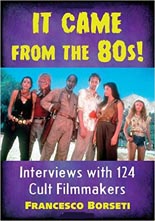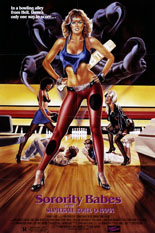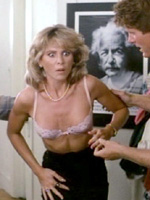
 As any child of the 1980s will tell you, the video store was an essential part of growing up. You discovered movies in a manner Netflix and other streaming services cannot replicate: by browsing boxes. And because you paid per movie, you actually watched them — actively, not “second-screen” passively — thus giving them a fairer shot than any click-happy finger does today under the all-you-can-eat model. As a result, you discovered some gems. They may not all have been “good,” but gems nonetheless.
As any child of the 1980s will tell you, the video store was an essential part of growing up. You discovered movies in a manner Netflix and other streaming services cannot replicate: by browsing boxes. And because you paid per movie, you actually watched them — actively, not “second-screen” passively — thus giving them a fairer shot than any click-happy finger does today under the all-you-can-eat model. As a result, you discovered some gems. They may not all have been “good,” but gems nonetheless.
If you thought it was a wild time to feed the VHS monkey with cassettes like Parasite, Slave Girls from Beyond Infinity and Cavegirl, imagine how much wilder it was to make them. Better yet, consume the concrete evidence that is It Came from the 80s!: Interviews with 124 Cult Filmmakers, the debut book from Italy-based film scholar Francesco Borseti. Published by McFarland & Company, it shares the behind-the-scenes drama of 28 low-budget features — stories that never have been revealed before, mostly because no one ever cared to ask.
Thank the rewind gods that he did, because Borseti often ends up with gold. The experience of reading — and watching the flicks themselves — can be summed up by three quotes, which I present to you with no further context:
1. “He wanted to direct and star in the film and do everything. But he did not know how to write, direct, or produce.”
2. “He will be shooting his own horror feature entitled Demonic Aborted Sewer Fecal Fetuses Revenge. If a script I wrote inspired someone to be creative, yes, that’s worth something.”
3. “He was an alcoholic, and he lost his pants just before he was due on camera.”
 It Came from the 80s! isn’t “written” so much as transcribed or perhaps even copy/pasted, as many interviews were conducted through email. Not among the 124 subjects, oddly enough, is director David DeCoteau, who seems like he’d pick up your dry cleaning for $10, and is repped here by a pair of his early pictures, Creepozoids and Sorority Babes in the Slimeball Bowl-O-Rama. His name is constantly dropped, as is Charles Band’s — an anecdotal trend throughout, rivaled only by suspected mob ties, directors taking undeserved credits and the number of porno filmmakers trying to go legit using straight-to-video horror and sci-fi as their express pass into the mainstream.
It Came from the 80s! isn’t “written” so much as transcribed or perhaps even copy/pasted, as many interviews were conducted through email. Not among the 124 subjects, oddly enough, is director David DeCoteau, who seems like he’d pick up your dry cleaning for $10, and is repped here by a pair of his early pictures, Creepozoids and Sorority Babes in the Slimeball Bowl-O-Rama. His name is constantly dropped, as is Charles Band’s — an anecdotal trend throughout, rivaled only by suspected mob ties, directors taking undeserved credits and the number of porno filmmakers trying to go legit using straight-to-video horror and sci-fi as their express pass into the mainstream.
Included among the book’s 300 pages are such tantalizing tales as:
• how the AIDS epidemic affected the title of Blue Monkey, through three differing accounts;
• the dilemma of whether to get erect or not during the shooting of The Carpenter’s sex scenes;
• the infamous producer Harry Alan Towers‘ habits of visiting high-class hookers and bouncing checks to his screenwriters;
• Anthony Franciosa having to read his Zombie Death House lines off bread loaves;
• Dan Haggerty’s drunken rants between takes of The Chilling;
• how Roger Corman’s Gremlins-“inspired” Munchies can be used as leverage to score pot in Hawaii;
• and how crew members of Terror Night (aka Bloody Movie), while shooting at an actual nunnery, had to keep nuns from walking in on a sex scene between Michelle Bauer and actor Jimi Elwell, who claims the following: “I remember she was sitting on my face and then sliding down to my crotch. After the second or third take, I looked down at my chest and seeing a trail of female juice, I said to her, ‘Nice snail trail, you’re having fun!'”
 Much more fun is to be had. Borseti could have done a better job in editing the conversations of the few people who are so long-winded, they venture into unrelated tangents. For example, I don’t care what the director of Deadly Intruder thinks about our nation’s health care system. I do care, however — and deeply — about Elizabeth Foxx’s memories making the T&A romp School Spirit; it’s just a shame the actress is not among those weighing in on that invisible-boy sex comedy. And that’s really my only complaint. —Rod Lott
Much more fun is to be had. Borseti could have done a better job in editing the conversations of the few people who are so long-winded, they venture into unrelated tangents. For example, I don’t care what the director of Deadly Intruder thinks about our nation’s health care system. I do care, however — and deeply — about Elizabeth Foxx’s memories making the T&A romp School Spirit; it’s just a shame the actress is not among those weighing in on that invisible-boy sex comedy. And that’s really my only complaint. —Rod Lott
